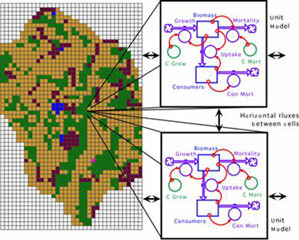|
The Northern Forest has changed dramatically over the past 15 years. Attempts to control rapid landuse change confront a range of conflicting goals, often between ecological and socio-economic priorities. It is an area where the worldview and methods of ecological economics may be productively applied to promote economic development in harmony with the health of the ecosystems.
The State of Vermont has initiated an ongoing basin planning process, through which watershed plans will be developed for 17 major river basins by the year 2006. As in other watershed management efforts, it is clearly recognized that the flow of water serves both as an indicator of the relief and landscape characteristics, and as an integrator of many of the processes occurring within the watershed. Therefore watershed planning is not only about water, but it is also about all the ecological and socio-economic processes in the watershed. It provides a forum for making difficult decisions in basins that lie within the Northern Forest.
We have developed a multi-scale, modular, spatial modeling environment (SME - Maxwell and Costanza, 1997a,b; Maxwell, 2002) and a suite of models and modules assembled into a Library of Hydro-ecological Modules (LHEM - Voinov et al., 2003) for a range of spatial, temporal, and complexity scales from individual sites to watersheds. This allows us to integrate site-specific information with regional, GIS, and remote sensing data. The models are process-based, spatially explicit, dynamic, non-linear simulations of the landscape (including carbon, water, nitrogen, phosphorous, plants, consumers (including humans) and a range of ecosystem services) under various climate, economic, and policy scenarios. The approach has been successfully applied in a range of ecosystems to a range of management problems in Louisiana, Florida, and Maryland. These models have developed into a general watershed modeling approach that includes all the steps essential for model design, calibration, testing, application and dissemination.
(The text above is taken from the project website, see link below)
Web links:
|




